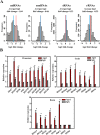Evidence for the expression of abundant microRNAs in the locust genome
- PMID: 26329925
- PMCID: PMC4556993
- DOI: 10.1038/srep13608
Evidence for the expression of abundant microRNAs in the locust genome
Abstract
Substantial accumulation of neutral sequences accounts for genome size expansion in animal genomes. Numerous novel microRNAs (miRNAs), which evolve in a birth and death manner, are considered evolutionary neutral sequences. The migratory locust is an ideal model to determine whether large genomes contain abundant neutral miRNAs because of its large genome size. A total of 833 miRNAs were discovered, and several miRNAs were randomly chosen for validation by Northern blot and RIP-qPCR. Three additional verification methods, namely, processing-dependent methods of miRNA biogenesis using RNAi, evolutionary comparison with closely related species, and evidence supported by tissue-specific expression, were applied to provide compelling results that support the authenticity of locust miRNAs. We observed that abundant local duplication events of miRNAs, which were unique in locusts compared with those in other insects with small genome sizes, may be responsible for the substantial acquisition of miRNAs in locusts. Together, multiple evidence showed that the locust genome experienced a burst of miRNA acquisition, suggesting that genome size expansion may have considerable influences of miRNA innovation. These results provide new insight into the genomic dynamics of miRNA repertoires under genome size evolution.
Figures





Similar articles
-
MicroRNA-dependent development revealed by RNA interference-mediated gene silencing of LmDicer1 in the migratory locust.Insect Sci. 2013 Feb;20(1):53-60. doi: 10.1111/j.1744-7917.2012.01542.x. Epub 2012 Jul 31. Insect Sci. 2013. PMID: 23955825
-
Characterization and comparative profiling of the small RNA transcriptomes in two phases of locust.Genome Biol. 2009;10(1):R6. doi: 10.1186/gb-2009-10-1-r6. Epub 2009 Jan 16. Genome Biol. 2009. PMID: 19146710 Free PMC article.
-
MicroRNA genes derived from repetitive elements and expanded by segmental duplication events in mammalian genomes.PLoS One. 2011 Mar 16;6(3):e17666. doi: 10.1371/journal.pone.0017666. PLoS One. 2011. PMID: 21436881 Free PMC article.
-
A bird's-eye view on the modern genetics workflow and its potential applicability to the locust problem.C R Biol. 2013 Aug;336(8):375-83. doi: 10.1016/j.crvi.2013.07.002. Epub 2013 Aug 22. C R Biol. 2013. PMID: 24018194 Review.
-
miRNAs: small genes with big potential in metazoan phylogenetics.Mol Biol Evol. 2013 Nov;30(11):2369-82. doi: 10.1093/molbev/mst133. Epub 2013 Aug 2. Mol Biol Evol. 2013. PMID: 23913097 Review.
Cited by
-
Piwi/piRNAs control food intake by promoting neuropeptide F expression in locusts.EMBO Rep. 2022 Feb 3;23(3):e50851. doi: 10.15252/embr.202050851. Epub 2022 Jan 5. EMBO Rep. 2022. PMID: 34985794 Free PMC article.
-
Novel equine tissue miRNAs and breed-related miRNA expressed in serum.BMC Genomics. 2016 Oct 26;17(1):831. doi: 10.1186/s12864-016-3168-2. BMC Genomics. 2016. PMID: 27782799 Free PMC article.
-
miR-71 and miR-263 Jointly Regulate Target Genes Chitin synthase and Chitinase to Control Locust Molting.PLoS Genet. 2016 Aug 17;12(8):e1006257. doi: 10.1371/journal.pgen.1006257. eCollection 2016 Aug. PLoS Genet. 2016. PMID: 27532544 Free PMC article.
-
Optogenetic manipulation of medullary neurons in the locust optic lobe.J Neurophysiol. 2018 Oct 1;120(4):2049-2058. doi: 10.1152/jn.00356.2018. Epub 2018 Aug 15. J Neurophysiol. 2018. PMID: 30110231 Free PMC article.
-
Identification and profiling of stable microRNAs in hemolymph of young and old Locusta migratoria fifth instars.Curr Res Insect Sci. 2022 Jun 17;2:100041. doi: 10.1016/j.cris.2022.100041. eCollection 2022. Curr Res Insect Sci. 2022. PMID: 36003267 Free PMC article.
References
Publication types
MeSH terms
Substances
LinkOut - more resources
Full Text Sources
Other Literature Sources
Miscellaneous

